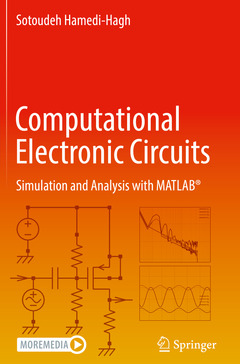Description
Computational Electronic Circuits, 1st ed. 2022
Simulation and Analysis with MATLAB®
Language: English
Subject for Computational Electronic Circuits:
Publication date: 08-2022
431 p. · 15.5x23.5 cm · Paperback
Publication date: 08-2021
431 p. · 15.5x23.5 cm · Hardback
Description
/li>Contents
/li>Biography
/li>Comment
/li>
This textbook teaches in one, coherent presentation the three distinct topics of analysis of electronic circuits, mathematical numerical algorithms and coding in a software such as MATLAB®. By combining the capabilities of circuit simulators and mathematical software, the author teaches key concepts of circuit analysis and algorithms, using a modern approach. The DC, Transient, AC, Noise and behavioral analyses are implemented in MATLAB to study the complete characteristics of a variety of electronic circuits, such as amplifiers, rectifiers, hysteresis circuits, harmonic traps and passes, polyphaser filters, directional couplers, electro-static discharge and piezoelectric crystals. This book teaches basic and advanced circuit analysis, by incorporating algorithms and simulations that teach readers how to develop their own simulators and fully characterize and design electronic circuits.
- Teaches students and practitioners DC, AC, Transient, Noise and Behavioral analyses using MATLAB;
- Shows readers how to create their own complete simulator in MATLAB by adding materials learned in all 6 chapters of the book;
- Balances theory, math and analysis;
- Introduces many examples such as noise minimization, parameter optimization, power splitters, harmonic traps and passes, directional couplers, polyphase filters and electro-static discharge that are hardly referenced in other textbooks;
- Teaches how to create the fundamental analysis functions such as linear and nonlinear equation solvers, determinant calculation, random number generation and Fast Fourier transformation rather than using the built-in native MATLAB codes.
Introduction.- Framework.- DC Analysis.- Transient Analysis.- AC Analysis.- Noise Analysis.- Behavioral Analysis.
Sotoudeh Hamedi-Hagh received a Ph.D. from the University of Toronto, Canada, and joined the Electrical Engineering Department at San Jose State University, CA, in 2005 as an Assistant Professor. He became an Associate Professor in 2011 and a Full Professor in 2017. He developed the state-of-the-art RFIC lab and curriculum and directed the RFIC design center at SJSU. His research areas include design of high frequency Analog, Mixed-Signal and RF integrated circuits and systems, modeling nanoscale semiconductor devices and development of circuit simulators and algorithms. He created the Suspendance and the Trajectance circuits analysis methods and published them at IEEE conferences and journals.




